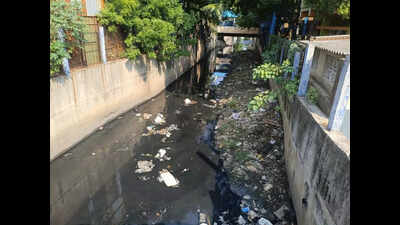Residents call out GCC for letting toxic waste clog Kodungaiyur canal – Times of India

Report on Environmental Degradation and Public Health Risks in Kodungaiyur Canal, Chennai
1.0 Introduction
This report addresses the critical environmental and public health situation at the Kodungaiyur canal’s zero point in Muthamizh Nagar, Chennai. The persistent and unchecked discharge of industrial effluents and raw sewage into the canal via stormwater drains constitutes a significant failure in urban environmental management. This issue directly contravenes several key United Nations Sustainable Development Goals (SDGs), particularly those related to health, clean water, and sustainable communities.
2.0 Key Findings
- Source of Pollution: The primary sources of contamination are illegal discharges of chemical waste from local industries, including a steel factory, and untreated sewage from residential buildings.
- Institutional Failure: Despite official claims of flood mitigation efforts, the Greater Chennai Corporation (GCC) has reportedly failed to desilt the canal’s zero point or prevent the illegal discharge, ignoring repeated complaints from residents.
- Public Health Impact: The polluted canal has become a significant health hazard, characterized by a foul odour and discoloured water. The proximity of two schools has led to reports of illness among students.
3.0 Alignment with Sustainable Development Goals (SDGs)
The situation in Kodungaiyur represents a severe lapse in progress toward multiple SDGs:
- SDG 3: Good Health and Well-being: The continuous exposure of residents and school children to toxic waste and sewage directly undermines public health. The reported illnesses among at least 20 students highlight a failure to ensure healthy lives and promote well-being for all.
- SDG 6: Clean Water and Sanitation: The contamination of the canal is a direct violation of the goal to ensure the availability and sustainable management of water and sanitation. The use of stormwater drains for sewage and industrial waste demonstrates inadequate sanitation infrastructure and water quality management.
- SDG 11: Sustainable Cities and Communities: The failure to manage industrial and domestic waste effectively compromises the objective of making cities inclusive, safe, resilient, and sustainable. The environmental hazard degrades the quality of urban life for the residents of Muthamizh Nagar.
- SDG 12: Responsible Consumption and Production: The illegal dumping by industries points to a failure in ensuring sustainable production patterns and holding corporations accountable for their environmental impact.
- SDG 16: Peace, Justice, and Strong Institutions: The reported indifference of the civic body to residents’ complaints indicates a weakness in local institutional effectiveness and accountability, hindering the development of a just and responsive governance structure.
4.0 Official Response and Current Status
- The Tondiarpet zonal officer has acknowledged the issue and has reportedly taken the following steps:
- Informed the Tamil Nadu Pollution Control Board to take action against the polluting industries, including the imposition of penalties.
- Requested Metrowater to provide official sewage connections to nearby residential buildings to curtail the illegal discharge of domestic waste into drains.
Analysis of Sustainable Development Goals in the Article
1. Which SDGs are addressed or connected to the issues highlighted in the article?
-
SDG 3: Good Health and Well-being
- The article directly connects the pollution to health problems. It mentions that the polluted canal has turned the area into a “health hazard” and that “at least 20 students have fallen ill due to the filthy water and unbearable odour.” This highlights the direct impact of environmental degradation on human health.
-
SDG 6: Clean Water and Sanitation
- The central theme of the article is the contamination of a water body, the Kodungaiyur canal. It details how “industrial effluents and sewage continue to flow unchecked” into the canal. The lack of proper sewage connections and the illegal discharge of untreated wastewater are core issues related to this goal.
-
SDG 11: Sustainable Cities and Communities
- The issue is located in an urban setting (Chennai) and involves the failure of a municipal body (Greater Chennai Corporation) to manage waste and pollution. The article discusses the “civic body’s indifference,” its failure in “flood mitigation works” due to not removing garbage, and the overall negative environmental impact on a residential area, which are all concerns under SDG 11.
-
SDG 12: Responsible Consumption and Production
- The article specifies that “chemical waste from nearby industries, including a steel factory, are being discharged illegally.” This points to a failure in the environmentally sound management of industrial waste and chemicals, which is a key aspect of SDG 12.
2. What specific targets under those SDGs can be identified based on the article’s content?
-
Target 3.9: By 2030, substantially reduce the number of deaths and illnesses from hazardous chemicals and air, water and soil pollution and contamination.
- The article’s statement that the pollution poses “serious health hazards” and has caused students to fall ill directly relates to reducing illnesses caused by water pollution and hazardous chemical waste.
-
Target 6.3: By 2030, improve water quality by reducing pollution, eliminating dumping and minimizing release of hazardous chemicals and materials, halving the proportion of untreated wastewater.
- The article describes the “continuous discharge of chemical waste and sewage” and the illegal dumping of industrial effluents and garbage into the canal, which are the exact problems this target aims to solve. The authorities’ plan to provide sewage connections is a step towards managing untreated wastewater.
-
Target 11.6: By 2030, reduce the adverse per capita environmental impact of cities, including by paying special attention to air quality and municipal and other waste management.
- The failure of the GCC to “desilt and remove garbage” and stop the flow of sewage and industrial waste into the canal demonstrates a lapse in municipal waste management, leading to a significant adverse environmental impact on the city’s residents.
-
Target 12.4: By 2020, achieve the environmentally sound management of chemicals and all wastes throughout their life cycle… and significantly reduce their release to air, water and soil in order to minimize their adverse impacts on human health and the environment.
- The illegal discharge of “chemical waste” from industries, which sometimes “turns red or orange,” is a clear example of the improper management and release of chemicals and industrial waste into the environment, directly impacting water and human health.
3. Are there any indicators mentioned or implied in the article that can be used to measure progress towards the identified targets?
-
Implied Indicator for Target 3.9 (Indicator 3.9.2): Mortality rate attributed to unsafe water, unsafe sanitation and lack of hygiene.
- While the article does not mention deaths (mortality), it explicitly reports on illnesses (morbidity) by stating that “at least 20 students have fallen ill.” This serves as a direct measure of the health impact of unsafe water and sanitation in the area.
-
Implied Indicator for Target 6.3 (Indicator 6.3.1): Proportion of domestic and industrial wastewater flows safely treated.
- The article implies that the proportion of safely treated wastewater is extremely low or zero. Phrases like “sewage continue to flow unchecked” and “discharged illegally into stormwater drains” indicate a complete lack of treatment for both domestic and industrial wastewater in this specific location.
-
Implied Indicator for Target 11.6 (Indicator 11.6.1): Proportion of municipal solid waste collected and managed in controlled facilities.
- The article mentions the GCC’s failure to “remove garbage from the link channel,” suggesting that solid waste is not being properly collected and managed, but is instead ending up in the city’s waterways. This reflects a failure in municipal waste management systems.
-
Implied Indicator for Target 12.4 (Indicator 12.4.1): Number of parties to international multilateral environmental agreements on hazardous waste…that meet their commitments.
- At a local level, the illegal discharge of chemical waste and the involvement of the Tamil Nadu Pollution Control Board to “impose penalties on the company responsible” imply a failure to adhere to national environmental regulations for hazardous waste. This reflects a lack of compliance, which this indicator aims to track on a broader scale.
Summary Table of SDGs, Targets, and Indicators
| SDGs | Targets | Indicators |
|---|---|---|
| SDG 3: Good Health and Well-being | Target 3.9: Substantially reduce illnesses from hazardous chemicals and water pollution. | Indicator (Implied): Number of illnesses attributed to unsafe water and sanitation (e.g., “at least 20 students have fallen ill”). |
| SDG 6: Clean Water and Sanitation | Target 6.3: Improve water quality by reducing pollution and eliminating the dumping of untreated wastewater. | Indicator (Implied): Proportion of untreated wastewater (e.g., “industrial effluents and sewage continue to flow unchecked”). |
| SDG 11: Sustainable Cities and Communities | Target 11.6: Reduce the adverse per capita environmental impact of cities, focusing on waste management. | Indicator (Implied): Proportion of unmanaged municipal waste (e.g., GCC’s failure to “remove garbage from the link channel”). |
| SDG 12: Responsible Consumption and Production | Target 12.4: Achieve environmentally sound management of chemicals and all wastes. | Indicator (Implied): Incidents of non-compliance with hazardous waste regulations (e.g., “chemical waste…being discharged illegally”). |
Source: timesofindia.indiatimes.com
What is Your Reaction?
 Like
0
Like
0
 Dislike
0
Dislike
0
 Love
0
Love
0
 Funny
0
Funny
0
 Angry
0
Angry
0
 Sad
0
Sad
0
 Wow
0
Wow
0
















































/environment-climate-change-and-health-(ech)/water-sanitation-hygiene-and-health-(wsh)/landfill-tuvalu-36092.tmb-1200v.jpg?sfvrsn=5c21fe40_1#)

.jpg.webp?itok=0ZsAnae9#)
























